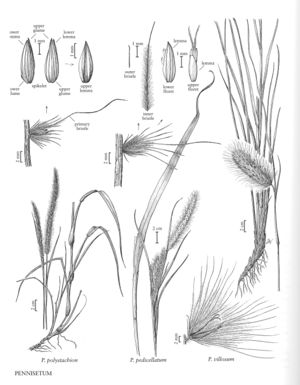Difference between revisions of "Pennisetum pedicellatum"
FNA>Volume Importer |
FNA>Volume Importer |
||
| Line 41: | Line 41: | ||
|publication year= | |publication year= | ||
|special status= | |special status= | ||
| − | |source xml=https://jpend@bitbucket.org/aafc-mbb/fna-data-curation.git/src/ | + | |source xml=https://jpend@bitbucket.org/aafc-mbb/fna-data-curation.git/src/f6b125a955440c0872999024f038d74684f65921/coarse_grained_fna_xml/V25/V25_1361.xml |
|subfamily=Poaceae subfam. Panicoideae | |subfamily=Poaceae subfam. Panicoideae | ||
|tribe=Poaceae tribe Paniceae | |tribe=Poaceae tribe Paniceae | ||
Revision as of 20:22, 24 September 2019
Plants usually annual, occasion¬ally perennial; cespitose. Culms 40-150 cm, erect, branching; nodes glabrous. Sheaths glabrous, margins ciliate; ligules 1-2 mm; blades 6-30 cm long, 4-15 mm wide, flat, pubescent, basal margins ciliate. Panicles terminal and axillary, (5)8-19 cm long, 30-35 mm wide, erect, pink to purple; rachises terete, puberulent at the base. Fascicles 14-15 per cm, disarticulating at maturity; fascicle axes 1.5-2.5 mm, with (1)2-5 spikelets; outer bristles 10-20, 1.2-2 mm, scabrous; inner bristles 40-90, 2.2-14 mm, long ciliate; primary bristles 15-25 mm, long-ciliate, noticeably longer than the other bristles. Spikelets 3.4-4.8 mm; pedicels 0.5-3.5 mm; lower glumes 1.2-2.4 mm, 0-1-veined; upper glumes 3.4-4.8 mm, glabrous, 5-veined; lower florets staminate or sterile; lower lemmas 3.1-4 mm, 5(6)-veined; lower paleas 2.5-3.5 mm; anthers 3, 2.2-2.5 mm; upper florets disarticulating at maturity; upper lemmas 2-2.7 mm, coriaceous, smooth, shiny, 5-veined, margins glabrous, apices ciliate; anthers 1.5-2.5 mm. Caryopses about 1.7 mm, concealed by lemma and palea at maturity. 2n = 24, 30, 32, 35, 36.
Discussion
Pennisetum pedicellatum is native to Africa. It now grows in many other areas, including Florida. The U.S. Department of Agriculture considers it a noxious weed.
Selected References
None.
